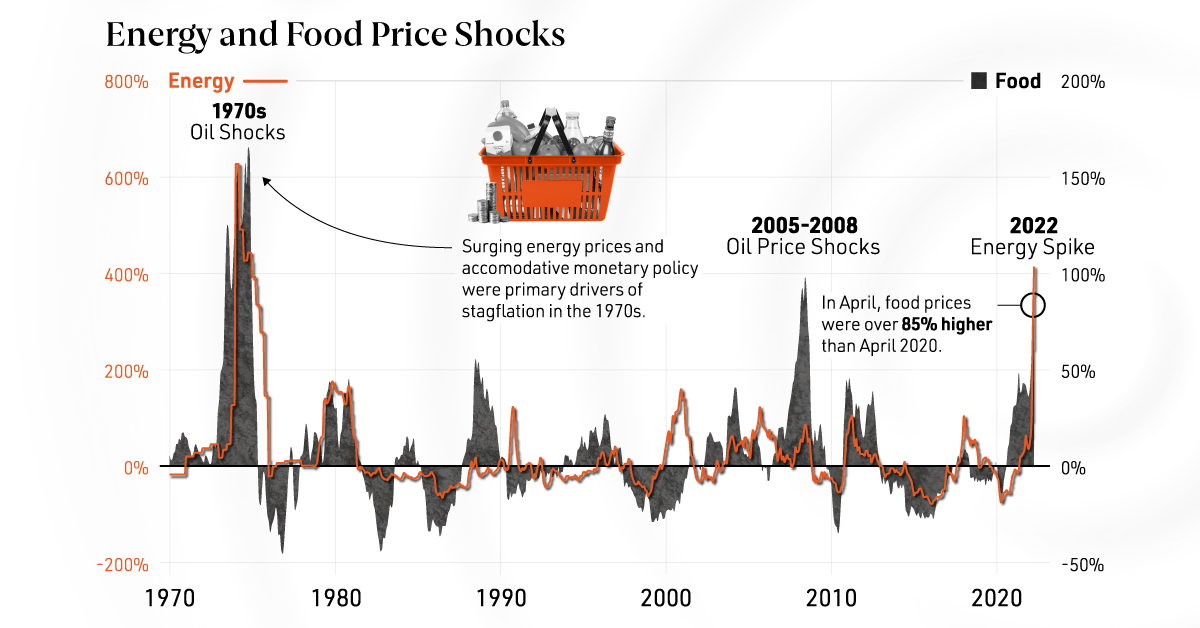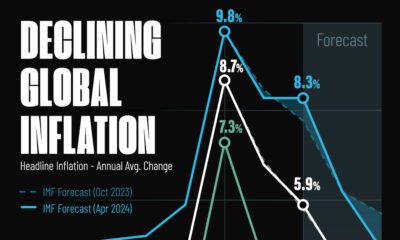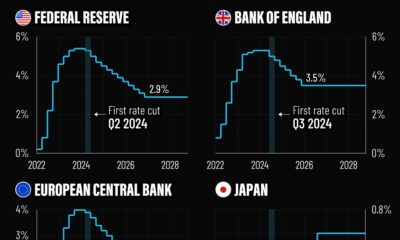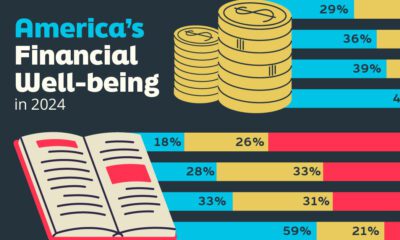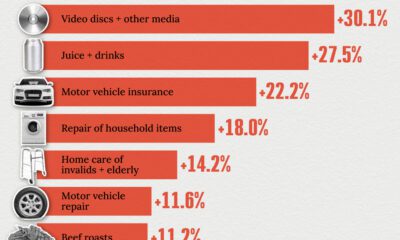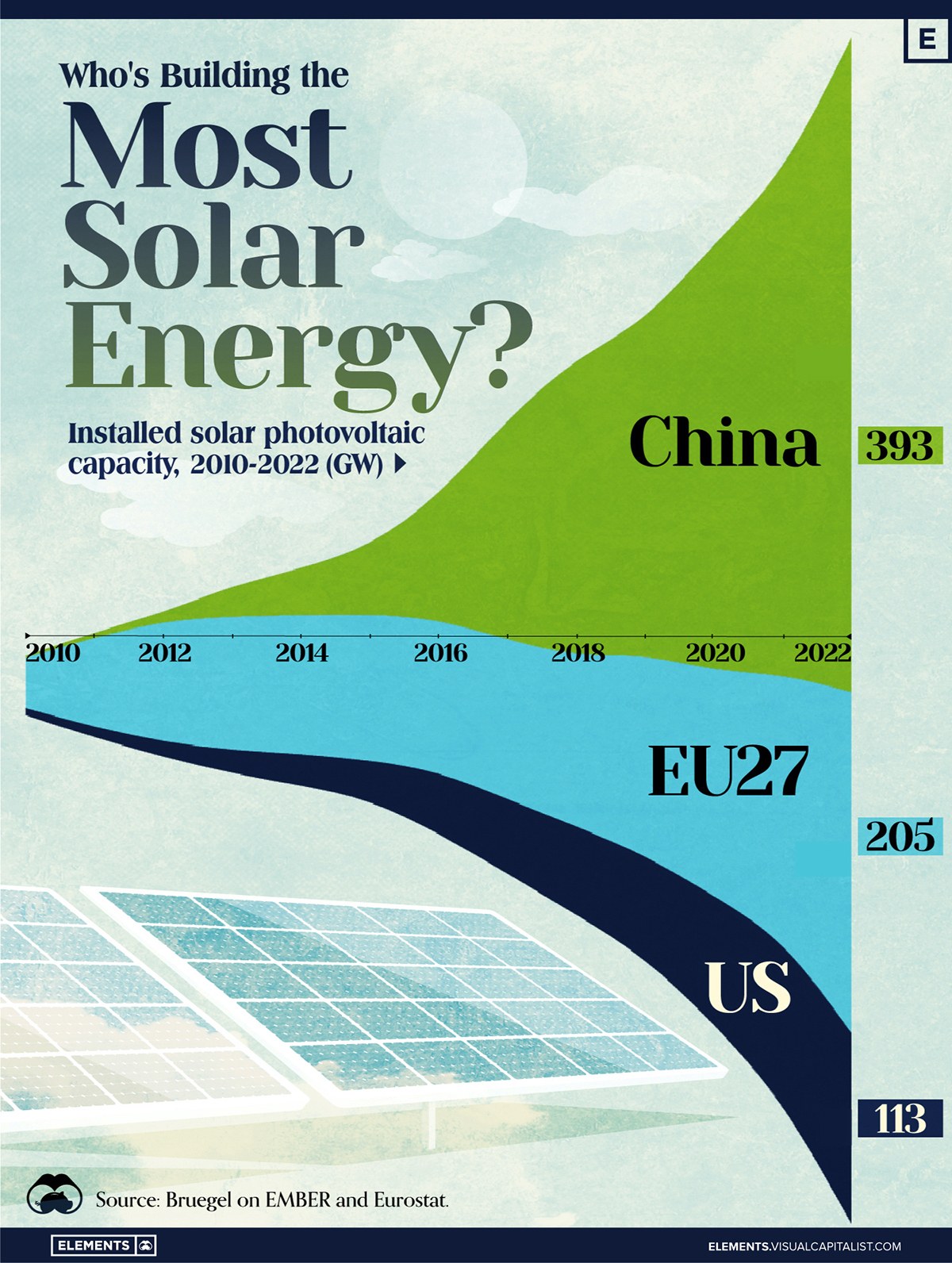Energy
The Inflation Factor: How Rising Food and Energy Prices Impact the Economy
![]() Subscribe to the Elements free mailing list for more like this
Subscribe to the Elements free mailing list for more like this
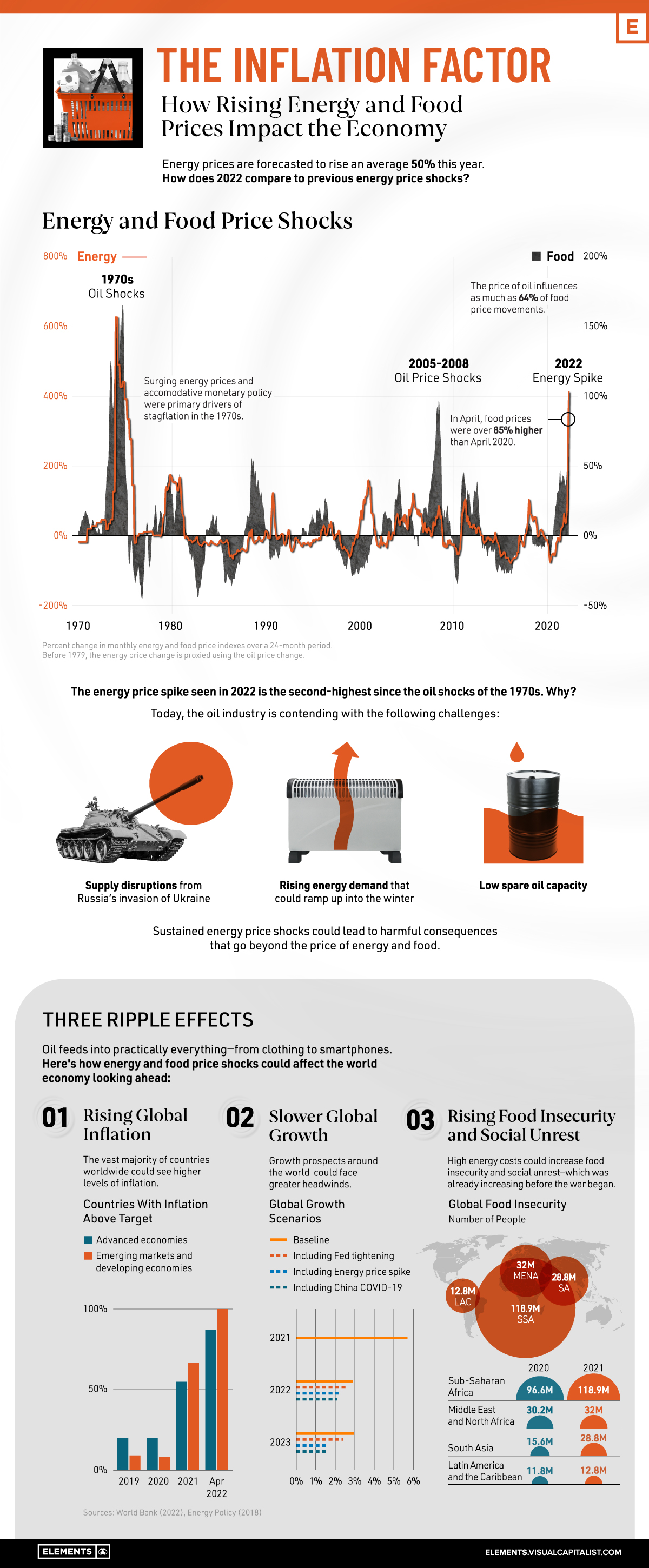
How Rising Food and Energy Prices Impact the Economy
This was originally posted on Elements. Sign up to the free mailing list to get beautiful visualizations on natural resource megatrends in your email every week.
Since Russia’s invasion of Ukraine, the effects of energy supply disruptions are cascading across everything from food prices to electricity to consumer sentiment.
In response to soaring prices, many OECD countries are tapping into their strategic petroleum reserves. In fact, since March, the U.S. has sold a record one million barrels of oil per day from these reserves. This, among other factors, has led gasoline prices to fall more recently—yet deficits could follow into 2023, causing prices to increase.
With data from the World Bank, the above infographic charts energy shocks over the last half century and what this means for the global economy looking ahead.
Energy Price Shocks Since 1979
How does today’s energy price shock compare to previous spikes in real terms?
| U.S.$/bbl Equivalent | Crude Oil | Natural Gas | Coal |
|---|---|---|---|
| 2022* | $93 | $170 | $61 |
| 2008 | $127 | $100 | $46 |
| 1979 | $119 | $72 | $33 |
*2022 forecast
As the above table shows, the annual price of crude oil is forecasted to average $93 per barrel equivalent in 2022. By comparison, during the 2008 and 1979 price shocks, crude oil averaged $127 and $119 per barrel, respectively.
What distinguishes the 2022 energy spike is that prices have soared across all fuels. Where price shocks were more or less isolated in the past, many countries such as Germany and the Netherlands are looking to coal to make up for oil supply disruptions. Meanwhile, European natural gas prices have hit record highs.
Food prices have also spiked. Driven by higher input costs across fuel, chemicals, and fertilizer, agriculture commodity prices are forecasted to rise 18% in 2022. Fertilizer prices alone could increase 70% in part due to Russia’s dominance of the global fertilizer market—exporting more than any country worldwide.
What are 3 Ripple Effects of Rising Energy Prices?
Oil feeds into nearly everything, from food to smartphones. In fact, the price of oil influences as much as 64% of food price movements.
How could energy and food shocks affect the world economy in the near future, and why is a lot riding on the price of oil?
1. Rising Global Inflation
In 2022, inflation became a global phenomenon—impacting 100% of advanced countries and 87% of emerging markets and developing economies analyzed by the World Bank.
| Countries With Inflation Above Target | 2019 | 2020 | 2021 | Apr 2022 |
|---|---|---|---|---|
| Emerging Markets and Developing Economies | 20% | 20% | 55% | 87% |
| Advanced Economies | 9% | 8% | 67% | 100% |
Sample includes 31 emerging markets and developing economies and 12 advanced economies
By contrast, roughly two-thirds of advanced economies and just over half of emerging markets experienced inflation above target in 2021.
This has contributed to tighter monetary conditions. The table below shows how rising inflation in the U.S. has corresponded with interest rate hikes since the 1980s:
| Date | Core CPI at Beginning of Cycle | Magnitude of Rate Hikes Over Course of Tightening Cycle |
|---|---|---|
| 1979-81 | 9.3% | 9.0 p.p |
| 1983-84 | 4.6% | 3.0 p.p |
| 1986-89 | 3.6% | 4.0 p.p |
| 1994-95 | 2.8% | 3.0 p.p |
| 1999-00 | 2.0% | 1.75 p.p |
| 2004-06 | 1.9% | 4.25 p.p. |
| 2015-19 | 2.1% | 2.25 p.p |
| 2022-23 | 6.4% | 2.75 p.p |
2023 is an estimate based on market expectations of the level of the Fed Funds rate in mid-2023. U.S. Core CPI for 2023 based on latest data available.
In many cases, when the U.S. has rapidly tightened monetary policy in response to price pressures, emerging markets and developing economies have experienced financial crises amid higher borrowing costs.
2. Slower Global Growth
Energy price shocks could add greater headwinds to global growth prospects:
| Global Growth Scenarios | 2021 | 2022 | 2023 |
|---|---|---|---|
| Baseline | 5.7% | 2.9% | 3.0% |
| Including Fed tightening | 2.6% | 2.4% | |
| Including Energy price spike | 2.2% | 1.6% | |
| Including China COVID-19 | 2.1% | 1.5% |
Together, price spikes, hawkish monetary policy, and COVID-19 lockdowns in China could negatively impact global growth.
3. Rising Food Insecurity and Social Unrest
Even before the energy price shock of 2022, global food insecurity was increasing due to COVID-19 and mounting inflationary pressures.
| Number of People in Acute Food Insecurity | 2020 | 2021 |
|---|---|---|
| Sub-Saharan Africa | 97M | 119M |
| Middle East and North Africa | 30M | 32M |
| South Asia | 16M | 29M |
| Latin America and the Caribbean | 12M | 13M |
Sustained food shortages and high food prices could send millions into acute food insecurity.
In addition, high fuel and food prices are often correlated with mass protests, political violence, and riots. While Sri Lanka and Peru have already begun to see heightened riots, Turkey and Egypt are also at risk for social unrest as the cost of living accelerates and food insecurity worsens.
Global Challenges
Since World War II, oil price shocks have been a major constraint on economic growth. As the war in Ukraine continues, the outlook for today’s energy market is far from clear as a number of geopolitical factors could sway oil price movements and its corresponding effects.
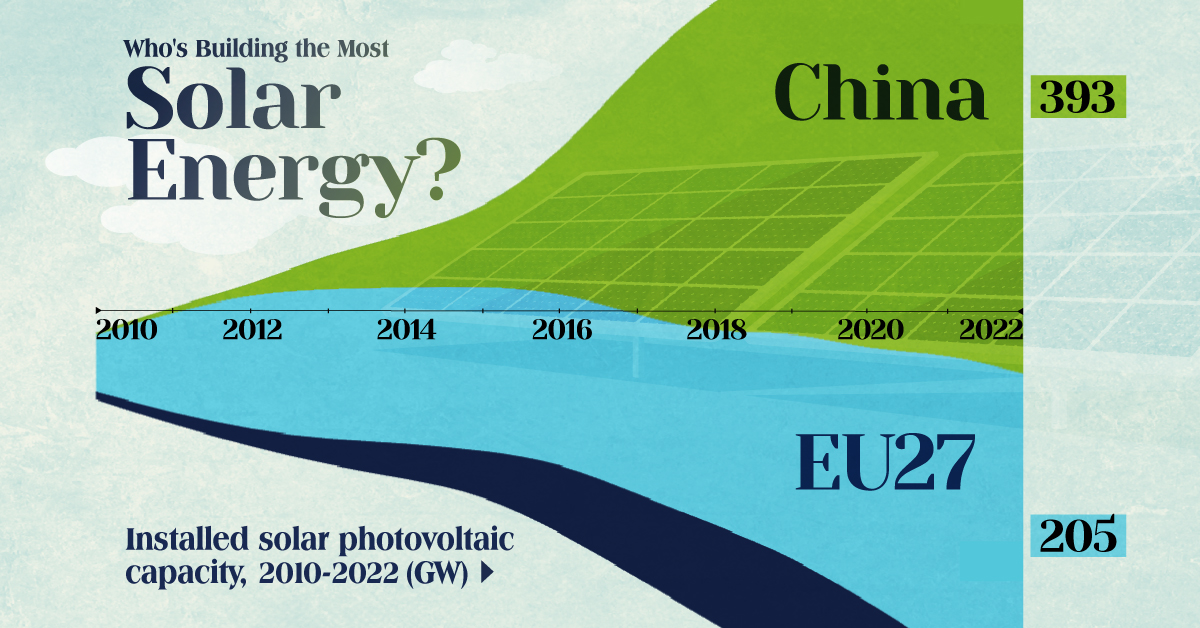
Who’s Building the Most Solar Energy?
This was originally posted on our Voronoi app. Download the app for free on iOS or Android and discover incredible data-driven charts from a variety of trusted sources.
In 2023, solar energy accounted for three-quarters of renewable capacity additions worldwide. Most of this growth occurred in Asia, the EU, and the U.S., continuing a trend observed over the past decade.
In this graphic, we illustrate the rise in installed solar photovoltaic (PV) capacity in China, the EU, and the U.S. between 2010 and 2022, measured in gigawatts (GW). Bruegel compiled the data..
Chinese Dominance
As of 2022, China’s total installed capacity stands at 393 GW, nearly double that of the EU’s 205 GW and surpassing the USA’s total of 113 GW by more than threefold in absolute terms.
| Installed solar capacity (GW) | China | EU27 | U.S. |
|---|---|---|---|
| 2022 | 393.0 | 205.5 | 113.0 |
| 2021 | 307.0 | 162.7 | 95.4 |
| 2020 | 254.0 | 136.9 | 76.4 |
| 2019 | 205.0 | 120.1 | 61.6 |
| 2018 | 175.3 | 104.0 | 52.0 |
| 2017 | 130.8 | 96.2 | 43.8 |
| 2016 | 77.8 | 91.5 | 35.4 |
| 2015 | 43.6 | 87.7 | 24.2 |
| 2014 | 28.4 | 83.6 | 18.1 |
| 2013 | 17.8 | 79.7 | 13.3 |
| 2012 | 6.7 | 71.1 | 8.6 |
| 2011 | 3.1 | 53.3 | 5.6 |
| 2010 | 1.0 | 30.6 | 3.4 |
Since 2017, China has shown a compound annual growth rate (CAGR) of approximately 25% in installed PV capacity, while the USA has seen a CAGR of 21%, and the EU of 16%.
Additionally, China dominates the production of solar power components, currently controlling around 80% of the world’s solar panel supply chain.
In 2022, China’s solar industry employed 2.76 million individuals, with manufacturing roles representing approximately 1.8 million and the remaining 918,000 jobs in construction, installation, and operations and maintenance.
The EU industry employed 648,000 individuals, while the U.S. reached 264,000 jobs.
According to the IEA, China accounts for almost 60% of new renewable capacity expected to become operational globally by 2028.
Despite the phasing out of national subsidies in 2020 and 2021, deployment of solar PV in China is accelerating. The country is expected to reach its national 2030 target for wind and solar PV installations in 2024, six years ahead of schedule.
-
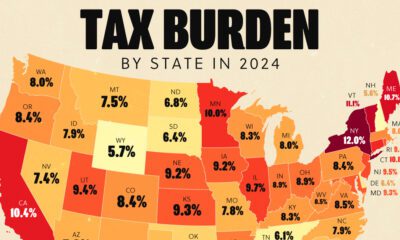
 Personal Finance1 week ago
Personal Finance1 week agoVisualizing the Tax Burden of Every U.S. State
-

 Misc7 days ago
Misc7 days agoVisualized: Aircraft Carriers by Country
-

 Culture7 days ago
Culture7 days agoHow Popular Snack Brand Logos Have Changed
-

 Mining1 week ago
Mining1 week agoVisualizing Copper Production by Country in 2023
-

 Misc1 week ago
Misc1 week agoCharted: How Americans Feel About Federal Government Agencies
-
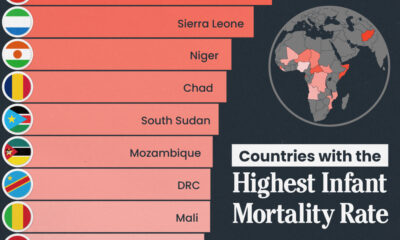
 Healthcare1 week ago
Healthcare1 week agoWhich Countries Have the Highest Infant Mortality Rates?
-
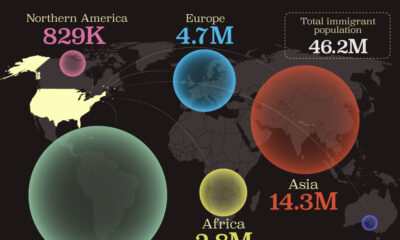
 Demographics1 week ago
Demographics1 week agoMapped: U.S. Immigrants by Region
-
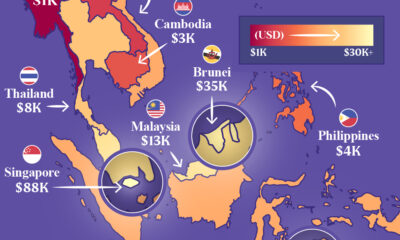
 Maps1 week ago
Maps1 week agoMapped: Southeast Asia’s GDP Per Capita, by Country

